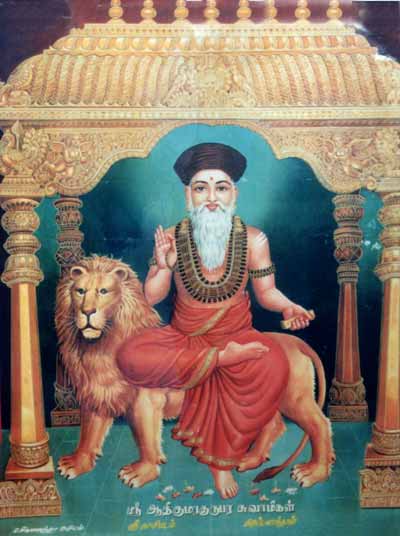
|
|||||||||
|
| |||||||||
Kumaragurupara Swamigal
A 17th century classic in praise of the glory of Tiruchendur is Kandar Kalivenba by Kumaragurupara Swamigal, a Saiva ascetic. The author was born in 1625 A.D. of a Saiva Vellala family at Srivaikuntam on the northern bank of the Tambaraparani, nineteen miles from Tiruchendur. His parents Shanmukha Sikhamani Kavirayar and Śivakami Ammaiyar were blessed with this child after a long penance to Muruga of Tiruchendur. The boy grew of age and until his fifth year showed no signs of speech. The parents were pained at this and resorted to Tiruchendur penance again. Weary of waiting for months and seeing signs of approaching speech, the parents determined to drown themselves in the sea along with the child if he would not speak by a particular day. The day dawned, and yet there were no signs. At last, both the parents and the child entered the foamy waves. Deeper and deeper they went from knee to neck and, as they were about to sink with the waves over their heads a human form appeared with a flower in his hand and asked the child what it was; when lo! the child broke out in praise of the Lord with the words of the lines. Pāmēvu teyvap pazhamaRaiyum…." This poem, the Kantarakalivempā of 244 lines is a delightful piece of the Lord's praise and the truths of Saiva Siddhanta. And it is considered even now with great propriety that its recitation with warmth and fervour wards off many an evil attending on man. Having studied Tamil at the feet of his father Sanmukacikāmani Kavirayar, and attained in it great proficiency by divine grace, he grew up to manhood, took to an austere way of life, left home, and wandered throughout the Tamil country visiting famous places of pilgrimage and composing poems on the presiding deities. When he was at Dharmapuram, he was drawn to the monastery's head Mācilāmani Tecikar, and begged him to be admitted as his disciple and initiated into the sannyāsa āsrama. Mācilāmani asked the young poet to visit important pilgrim centers including Benares, and return to him then. Kumarakuruparar felt incapable of such undertaking, arduous and dangerous in those days. He was directed to stay at least in Chidambaram for some time and then apply. He complied with this condition and afterwards took the holy orders. While he was a court-poet of Tirumalai Nāyaka at Madurai, one day as he was inaugurating his devotional poem in praise of goddess Mīnātci at the royal court, the goddess appeared herself as a young maiden and sat on the lap of the Nāyaka king, and taking a necklace of pearls, put it on the neck of the poet and vanished. Finally, Kumarakuruparar left for Benares. His fame reached even the Mughal court at Delhi. Emperor Aurangzib expressed a desire to see him, and the poet-saint (who had in the meantime mastered Urdu) rode to the Mughal court on the back of a lion, the symbol of courage and pride. The emperor was so much impressed by the poet's holiness and learning that he bestowed on him a plot of land in Benares near the Kedar Ghat, and there Kumarakuruparar built the Kumārasvāmi monastery which became soon the heart of religious activities. He lived in Benares till the end of his days except for a short visit to the South to pay his respects to his guru. The tradition also says that Kumarakuruparar who was very fond of Kampau's Tamil Rāmāyana lectured on it in Benares and that Tulsīdās, the great Hindi poet of Rāmcaritmānas, heard these talks and became indebted to Kanpan through the lectures of Kumarakuruparar. Amongst Kumarakuruparar's other literary works, Meenakshi Pillai-Tamil, Meenakshi-kurram, Neethineri-Vilakkami Madhuraikkalampakam and others are ever popular and widely read.
|
